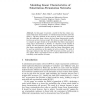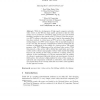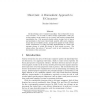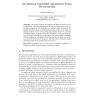SACRYPT
1999
Springer
14 years 3 months ago
1999
Springer
SACRYPT
1999
Springer
14 years 3 months ago
1999
Springer
Abstract. DES and triple-DES are two well-known and popular encryption algorithms, but they both have the same drawback: their block size is limited to 64 bits. While the cryptogra...
PKC
1999
Springer
14 years 3 months ago
1999
Springer
With the development of high speed computer networks, video service on the Web has huge market potential in that the video service can be provided to subscribers with greater time ...
PKC
1999
Springer
14 years 3 months ago
1999
Springer
Public-key implementers often face strong hardware-related constraints. In particular, modular operations required in most cryptosystems generally constitute a computational bottle...
PKC
1999
Springer
14 years 3 months ago
1999
Springer
PKC
1999
Springer
14 years 3 months ago
1999
Springer
Abstract. In a distributed system, dynamically dividing execution between nodes is essential for service robustness. However, when all of the nodes cannot be equally trusted, and w...
PKC
1999
Springer
14 years 3 months ago
1999
Springer
This paper introduces a method for tracking different copies of functionally equivalent algorithms containing identification marks known to the attacker. Unlike all previous solu...
PKC
1999
Springer
14 years 3 months ago
1999
Springer
Since many applications require the verification of large sets of signatures, it is sometimes advantageous to perform a simultaneous verification instead of checking each signatu...
PKC
1999
Springer
14 years 3 months ago
1999
Springer
PKC
1999
Springer
14 years 3 months ago
1999
Springer




